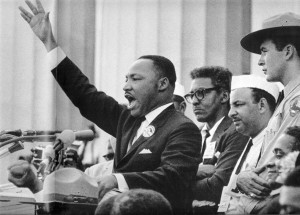The speech was good, the speaker nervous. Mahalia Jackson, behind Martin Luther King on the steps of the Lincoln Memorial, heard him hesitating. She yelled out, “tell them about the Dream, Martin!” King came alive and started adlibbing from his prepared text. It grew from its planned seven minutes to become one of the greatest speeches in American history.
Jackson, an internationally known gospel singer who had been with the movement through its most difficult days, was the only woman seated in the podium party. King, who had invited her, was the final speaker, a spot no one else wanted because they assumed that news reporters would have already left after a long day of speeches and song. But the press and the crowd of nearly 250,000 did wait and were rewarded by a thrilling moment of inspiration that climaxed the March on Washington for Jobs and Freedom. Fittingly, after King’s speech was finished, Mahalia Jackson returned to the podium and closed the event with a final song, “How I got over.”

Martin Luther King, Jr. and Coretta Scott King outside Montgomery on the Fourth Day of the March, Alabama Route 80, 1965.
Photo: Bob Adelman.
I learned about this day and much more at a memorable exhibition of photographs called The Movement at the Museum of Art in Fort Lauderdale. The photographs were all by Bob Adelman and follow the Civil Rights Movement and King from 1961 to the leader’s death in 1968. According to the curator, between 1963 and 1968, Adelman was a photographer for the Congress of Racial Equality, the Student Non-Violent Coordinating Committee, the NAACP Legal Defense Fund, and other civil rights organizations. Among the many magazines that have published his work are Esquire, Time, Life, New York, Harper’s, The New York Times Magazine, and Paris Match.
On August 28, 1963, Adelman was known not as a photographer but as a young activist in the movement. Since he wasn’t considered a member of the press, he had unusual access to the podium during the March of Washington. He was there to “see all my heroes, the people who were on the front lines.” At the exhibition, a blow up of his contact sheet of podium shots puts you up there along with Adelman as the speech unfolds.
Not only do his images bring you inside the Civil Rights movement, but they are tremendous photographs. According to Adelman, after King saw his images of protestors being sprayed by police hoses in Birmingham, he said, “I’m surprised that of all that pain, beauty came.”
The last room is devoted to King’s funeral ceremony at Morehouse College and is heart-breaking. His casket was carried in a procession from KIng’s Ebenezer Baptist Church in a simple mule drawn cart, like one you might see on a share-cropper’s farm. In what I believe are never published photographs, Adelman shows us the faces of the King’s family and other mourners as they pass in front of his open casket. We learn that Rosa Parks cried through the whole ceremony.
It is hard to calculate how much impact King’s speech had on the nation. President John F. Kennedy had never heard King give a speech before the March on Washington. Later that day, he invited King and the other organizers to the White House. When King entered the Oval Office, Kennedy shook his hand up and down, repeating, “I have a dream.”


